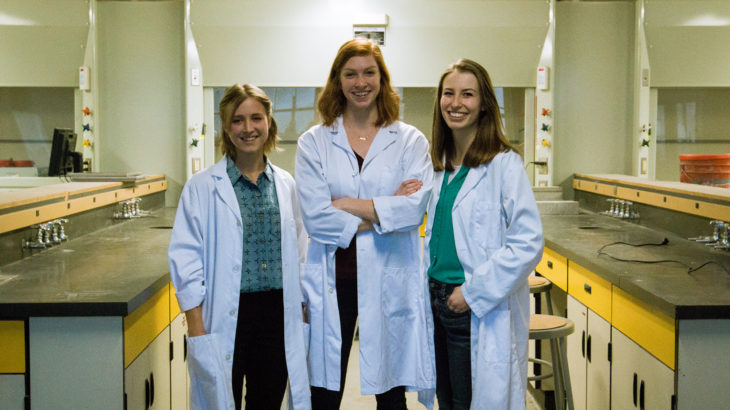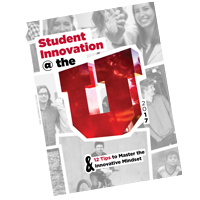For many women around the world, feminine hygiene products are not easily available or accessible. Women are often forced to stay home from school and work during their menstrual cycle. Alicia Dibble, Amber Barron and Ashlea Patterson, material science and engineering students, are working to solve this problem.
“When women can’t access any means to deal with their period, they stay home instead of going to work or school. It leads to a huge disparity between men and women in developing countries,” Barron said. With the help of Jeff Bates, an associate professor of material science and engineering, and Megan Shannahan, a business advisor for the engineering department, the students created a startup called SHERO — Sustainable Hygiene Engineering Research and Operations.
“The original need was for a super absorbent material that SHEVA (a local non-profit in Guatemala) could put into a pad,” Patterson said. “Once we began, the product morphed into an entirely biodegradable pad that women can make themselves in Guatemala. We are coming up with a ‘recipe’ of materials to make the pads, which can all be found at their local markets, such as banana peels, rice and cotton pads. We are also designing a press that women can use to press the materials into pads themselves, similar to a tortilla press.”
Not only are they designing biodegradable pads and presses for women in Guatemala, SHERO is also designing pads for women in the United States to fund the process. “The sale of the SHERO pad will go to making the pads, producing money to support educating Guatemalan women on menstrual cycles and sending the presses over,” Dibble said. These pads will be sold, packaged and pre-assembled, just like any other pad. But what sets them apart from other feminine hygiene products is that they will also be made of biodegradable material.
Over the course of the average American woman’s life, she will produce over 6,400 pounds of feminine hygiene waste, meaning one percent of landfill is women’s hygiene products, which are not biodegradable. “All of us are so devoted to this project and committed to making a difference. Everyone is excited to be a part of that. It’s an idea that everyone can get behind,” Barron said.
SHERO has received funding for their startup from Lassonde Entrepreneur Institute’s Get Seeded program, receiving $3,000 for research, prototyping and startup costs.
More articles like this in ‘Student Innovation @ the U!’
Find this article and a lot more in the 2017 “Student Innovation @ the U” report. The publication is presented by the Lassonde Entrepreneur Institute to celebrate student innovators, change-makers and entrepreneurs.





Ali,
I have budgeted money, up to $5000 to help with your product development.
I have several questions.
How will you use this money?
Do you have a plan or a list of priorities for the money?
Would Lassonde be classified as a non-profit entity?
Or, could I contribute directly to your team group.
Keep up the good work.
Please advise. Bob Orr
Please
We’ll forward your message to the SHERO team.
How can I find out more about helping/ supporting the team?
Email me at thad.kelling@utah.edu telling me who you are and how you want to get involved. Then I will forward that information to this group. – Thad Kelling
I am an undergraduate student at Rollins College in Winter Park, Florida. I am doing research through my college on 100% biodegradable pads to help contribute to Barefoot College’s ENRICHE health program which is supporting women’s menstrual health and sexual education primarily in Rajasthan, India. My team of fellow undergraduate students are compiling a larger report about menstrual health in India from an anthropological standpoint. I am primarily interested in the ecological effects of menstrual health products and hope to gain insight into the availability and cost of high quality biodegradable pad materials with the intention of making them more available in rural areas of India. If you would be inclined to contribute to my research I would appreciate a response either through a phone call or email about any of the following topics.
Is it possible to share more detailed information about the construction of SHERO pads, specifically the different layers and fusing process?
How did SHERO determine which materials were best to use for their purposes and any scientific research to support (if possible)?
Would it be a possible to arrange for a supply of your materials or the actual pads to Barefoot College in India?
Thank you very much for your time and commitment to your cause,
Anna Kaza
Rollins College undergraduate student
akaza@rollins.edu
We’ll forward your message to the team. Thanks for reaching out.
Good day
I am from South Africa.
Please could you send me the contact details for SHERO.
Many thanks.
We forwarded your message to the SHERO team.
I thought the team or the Engr advisor (can’t remember his name) would be intersted in this Gates opportunity:
https://gcgh.grandchallenges.org/challenge/innovations-materials-science-transformative-menstrual-health-and-hygiene-product-round-25Best